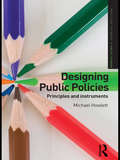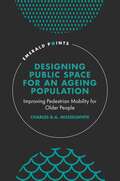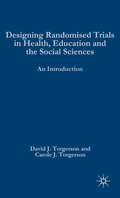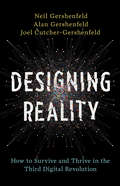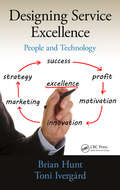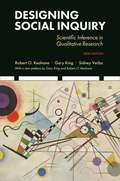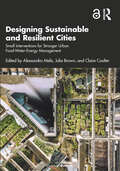- Table View
- List View
Designing Public Policies: Principles and Instruments (PDF)
by Michael HowlettThis textbook provides a concise and accessible introduction to the principles and elements of policy design in contemporary governance. Howlett seeks to examine in detail the range of substantive and procedural policy instruments that together comprise the toolbox from which governments select specific tools expected to resolve policy problems. Guiding students through the study of the instruments used by governments in carrying out their tasks, adapting to, and altering, their environments, this book: Discusses several current trends in instrument use often linked to factors such as globalization and the increasingly networked nature of modern society. Considers the principles behind the selection and use of specific types of instruments in contemporary government. Evaluates in detail the merits, demerits and rationales for the use of specific organization, regulatory, financial and information-based tools and the trends visible in their use Addresses the issues of instrument mixes and their (re)design in a discussion of the future research agenda of policy design. Providing a comprehensive overview of this essential component of modern governance and featuring helpful definitions of key concepts and further reading, this book is essential reading for all students of public policy, administration and management.
Designing Public Policies: Principles and Instruments (Routledge Textbooks in Policy Studies)
by Michael HowlettThe second edition of this highly regarded book provides a concise and accessible introduction to the principles and elements of policy design in contemporary governance. It examines in detail the range of substantive and procedural policy instruments that together comprise the toolbox from which governments choose tools to resolve policy problems and the principles and practices that lead to their use. Guiding readers through the study of the many different kinds of instruments used by governments in carrying out their tasks, adapting to, and altering, their environments, this book: Discusses current trends in instrument use linked to factors such as globalization and the increasingly networked, digital and collaborative nature of modern society; Considers the principles and practices behind the selection and use of specific types of instruments in contemporary government and the future research agenda of policy design studies and practices; Evaluates in detail the merits, demerits and rationales for the use of specific organization, regulatory, financial and information-based tools and the trends visible in their use including recent efforts to develop and deploy new tools such as nudges and choice architectures, co-production and crowd-sourcing; Addresses the issues surrounding not only individual tools but also concerning the evolution and development of instrument mixes, their relationship to policy styles and the challenges involved in their (re)design. Providing a comprehensive overview of this essential component of modern governance and featuring helpful definitions of key concepts and further reading, this book is essential reading for all students of public policy, administration and management.
Designing Public Policies: Principles and Instruments (Routledge Textbooks in Policy Studies)
by Michael HowlettThe second edition of this highly regarded book provides a concise and accessible introduction to the principles and elements of policy design in contemporary governance. It examines in detail the range of substantive and procedural policy instruments that together comprise the toolbox from which governments choose tools to resolve policy problems and the principles and practices that lead to their use. Guiding readers through the study of the many different kinds of instruments used by governments in carrying out their tasks, adapting to, and altering, their environments, this book: Discusses current trends in instrument use linked to factors such as globalization and the increasingly networked, digital and collaborative nature of modern society; Considers the principles and practices behind the selection and use of specific types of instruments in contemporary government and the future research agenda of policy design studies and practices; Evaluates in detail the merits, demerits and rationales for the use of specific organization, regulatory, financial and information-based tools and the trends visible in their use including recent efforts to develop and deploy new tools such as nudges and choice architectures, co-production and crowd-sourcing; Addresses the issues surrounding not only individual tools but also concerning the evolution and development of instrument mixes, their relationship to policy styles and the challenges involved in their (re)design. Providing a comprehensive overview of this essential component of modern governance and featuring helpful definitions of key concepts and further reading, this book is essential reading for all students of public policy, administration and management.
Designing Public Policies: Principles and Instruments (Routledge Textbooks in Policy Studies)
by MIchael Howlett Michael HowlettThe third edition of this highly regarded book provides a concise and accessible introduction to the principles and elements of policy design in contemporary governance. It examines in detail the range of substantive and procedural policy instruments that together comprise the toolbox from which governments choose tools to resolve policy problems and the principles and practices that lead to their use. Guiding readers through the study of the many different kinds of instruments used by governments in carrying out their tasks, adapting to, and altering, their environments, this book: • Considers the principles and practices behind the selection and use of specific types of Instruments in contemporary government and arrangements of policy tools esp. procedural tools and policy portfolios. • Evaluates in detail the merits, demerits, and rationales for the use of specific organization, regulatory, financial and information-based tools and the trends visible in their use. • Examines key issues such as policy success and failure and the role of design in it; policy volatility and risk management through policy design; how behavioural research can contribute to better policy designs; and the 'micro' calibrations of policies and their importance in designs and outcomes. • Addresses the issues not only surrounding individual tools but also concerning the evolution and development of instrument mixes, their relationship to policy styles and the challenges involved in their (re)design as well as the distinction between design and "non-design'. Providing a comprehensive overview of this essential component of modern governance and featuring helpful definitions of key concepts and further reading, this book is essential reading for all students of public policy, administration, and management.
Designing Public Policies: Principles and Instruments (Routledge Textbooks in Policy Studies)
by MIchael Howlett Michael HowlettThe third edition of this highly regarded book provides a concise and accessible introduction to the principles and elements of policy design in contemporary governance. It examines in detail the range of substantive and procedural policy instruments that together comprise the toolbox from which governments choose tools to resolve policy problems and the principles and practices that lead to their use. Guiding readers through the study of the many different kinds of instruments used by governments in carrying out their tasks, adapting to, and altering, their environments, this book: • Considers the principles and practices behind the selection and use of specific types of Instruments in contemporary government and arrangements of policy tools esp. procedural tools and policy portfolios. • Evaluates in detail the merits, demerits, and rationales for the use of specific organization, regulatory, financial and information-based tools and the trends visible in their use. • Examines key issues such as policy success and failure and the role of design in it; policy volatility and risk management through policy design; how behavioural research can contribute to better policy designs; and the 'micro' calibrations of policies and their importance in designs and outcomes. • Addresses the issues not only surrounding individual tools but also concerning the evolution and development of instrument mixes, their relationship to policy styles and the challenges involved in their (re)design as well as the distinction between design and "non-design'. Providing a comprehensive overview of this essential component of modern governance and featuring helpful definitions of key concepts and further reading, this book is essential reading for all students of public policy, administration, and management.
Designing public policy for co-production: Theory, practice and change
by Catherine Durose Liz RichardsonThis important book is a response to crises of public policy. Offering an original contribution to a growing debate, the authors argue that traditional technocratic ways of designing policy are inadequate to cope with increasingly complex challenges, and suggest co-production as a more democratic alternative. Drawing on 12 compelling international contributions from practitioners, policy makers, activists and actively engaged academics, ideas of power are used to explore how genuine democratic involvement in the policy process from those outside the elites of politics can shape society for the better. The authors present insights on why and how to generate change in policy processes, arguing for increased experimentation in policy design. The book will be a valuable resource for researchers and students in public policy, public administration, sociology and politics.
Designing public policy for co-production: Theory, practice and change
by Catherine Durose Liz RichardsonThis important book is a response to crises of public policy. Offering an original contribution to a growing debate, the authors argue that traditional technocratic ways of designing policy are inadequate to cope with increasingly complex challenges, and suggest co-production as a more democratic alternative. Drawing on 12 compelling international contributions from practitioners, policy makers, activists and actively engaged academics, ideas of power are used to explore how genuine democratic involvement in the policy process from those outside the elites of politics can shape society for the better. The authors present insights on why and how to generate change in policy processes, arguing for increased experimentation in policy design. The book will be a valuable resource for researchers and students in public policy, public administration, sociology and politics.
Designing Public Procurement Policy in Developing Countries: How to Foster Technology Transfer and Industrialization in the Global Economy
by Murat A. Yülek and Travis K. TaylorThis book presents effective strategies for developing countries to leverage their public sector demand for manufactured imports to promote industrialization, trade, and technology transfer. Technology transfer and its absorption is considered one of the most crucial and complicated challenges for developing countries, which are characterized by insufficient infrastructure, low technological intensity of the domestic capital stock, and high levels of manufactured imports. Which strategies and policy tools can governments employ to link demand with technology transfer, thereby enhancing absorption capacity and development in emerging economies?This book is part of a broader project launched by PGlobal Global Advisory and Training Services Ltd., in cooperation with Istanbul Commerce University (İTUCU) and the Scientific and Technological Research Council of Turkey (TÜBİTAK). The contributors to this book are policymakers, academicians, and experts who are working together to identify problems and develop policy recommendations for public procurement with respect to economic development. The book includes theoretical, empirical, and case study analyses of technology transfer mechanisms, public procurement policies, and countertrade and offset strategies. The lessons learned from these chapters will be of interest to both academics and policymakers concerned with technology transfer, industrial policy, and economic development.
Designing Public Space for an Ageing Population: Improving Pedestrian Mobility for Older People (Emerald Points)
by Charles B. A. MusselwhiteDesigning Public Space for an Ageing Population examines the barriers older people face by being a pedestrian in the built environment and demonstrates how to overcome them. Drawing on research carried out across the globe, and framed around Bourdieu's theory of capitals, this book establishes how to overcome restrictions and barriers to mobility including: - Infrastructure capital, such as technology, services, roads, pavements, finance and economics - Social capital, for example friends, family, neighbourhood and community - Cultural capital (norms, expectations, rules, laws) - Individual capital (skills, abilities, resilience, adaptation and desire and willingness to change) The book demonstrates that the public realm must be safe and accessible, but also attractive and desirable to an ageing population. The book includes case studies presenting solutions around CABE's objectives of urban design, notably: safe and accessible space including ease of movement; legible space, including adaptability, diversity and choice and; distinctive and aesthetically pleasing space, including character, continuity and quality.
Designing Public Space for an Ageing Population: Improving Pedestrian Mobility for Older People (Emerald Points)
by Charles B. A. MusselwhiteDesigning Public Space for an Ageing Population examines the barriers older people face by being a pedestrian in the built environment and demonstrates how to overcome them. Drawing on research carried out across the globe, and framed around Bourdieu's theory of capitals, this book establishes how to overcome restrictions and barriers to mobility including: - Infrastructure capital, such as technology, services, roads, pavements, finance and economics - Social capital, for example friends, family, neighbourhood and community - Cultural capital (norms, expectations, rules, laws) - Individual capital (skills, abilities, resilience, adaptation and desire and willingness to change) The book demonstrates that the public realm must be safe and accessible, but also attractive and desirable to an ageing population. The book includes case studies presenting solutions around CABE's objectives of urban design, notably: safe and accessible space including ease of movement; legible space, including adaptability, diversity and choice and; distinctive and aesthetically pleasing space, including character, continuity and quality.
Designing Randomised Trials in Health, Education and the Social Sciences: An Introduction
by D. TorgersonThe book focuses on the design of rigorous trials rather than their statistical underpinnings, with chapters on: pragmatic designs; placebo designs; preference approaches; unequal allocation; economics; analytical approaches; randomization methods. It also includes a detailed description of randomization procedures and different trial designs.
Designing Reality: How to Survive and Thrive in the Third Digital Revolution
by Neil Gershenfeld Alan Gershenfeld Joel Cutcher-GershenfeldThat's the promise, and peril, of the third digital revolution, where anyone will be able to make (almost) anythingTwo digital revolutions--computing and communication--have radically transformed our economy and lives. A third digital revolution is here: fabrication. Today's 3D printers are only the start of a trend, accelerating exponentially, to turn data into objects: Neil Gershenfeld and his collaborators ultimately aim to create a universal replicator straight out of Star Trek. While digital fabrication promises us self-sufficient cities and the ability to make (almost) anything, it could also lead to massive inequality. The first two digital revolutions caught most of the world flat-footed, thanks to Designing Reality that won't be true this time.
Designing Regulatory Policy
by David Besanko David E.M. SappingtonThis book reviews and interprets the literature that examines the design of regulatory policy when the regulator's knowledge of the relevant environment is limited. It will be useful to professional economists wishing to keep up with the development of their science.
Designing Regulatory Policy
by David Besanko David E.M. SappingtonThis book reviews and interprets the literature that examines the design of regulatory policy when the regulator's knowledge of the relevant environment is limited. It will be useful to professional economists wishing to keep up with the development of their science.
Designing San Francisco: Art, Land, and Urban Renewal in the City by the Bay
by Alison IsenbergA major new urban history of the design and development of postwar San FranciscoDesigning San Francisco is the untold story of the formative postwar decades when U.S. cities took their modern shape amid clashing visions of the future. In this pathbreaking and richly illustrated book, Alison Isenberg shifts the focus from architects and city planners—those most often hailed in histories of urban development and design—to the unsung artists, activists, and others who played pivotal roles in rebuilding San Francisco between the 1940s and the 1970s.Previous accounts of midcentury urban renewal have focused on the opposing terms set down by Robert Moses and Jane Jacobs—put simply, development versus preservation—and have followed New York City models. Now Isenberg turns our attention west to colorful, pioneering, and contentious San Francisco, where unexpectedly fierce battles were waged over iconic private and public projects like Ghirardelli Square, Golden Gateway, and the Transamerica Pyramid.When large-scale redevelopment came to low-rise San Francisco in the 1950s, the resulting rivalries and conflicts sparked the proliferation of numerous allied arts fields and their professionals, including architectural model makers, real estate publicists, graphic designers, photographers, property managers, builders, sculptors, public-interest lawyers, alternative press writers, and preservationists. Isenberg explores how these centrally engaged arts professionals brought new ideas to city, regional, and national planning and shaped novel projects across urban, suburban, and rural borders. San Francisco’s rebuilding galvanized far-reaching critiques of the inequitable competition for scarce urban land, and propelled debates over responsible public land stewardship. Isenberg challenges many truisms of this renewal era—especially the presumed male domination of postwar urban design, showing how women collaborated in city building long before feminism’s impact in the 1970s.An evocative portrait of one of the world’s great cities, Designing San Francisco provides a new paradigm for understanding past and present struggles to define the urban future.
Designing San Francisco: Art, Land, and Urban Renewal in the City by the Bay (PDF)
by Alison IsenbergA major new urban history of the design and development of postwar San FranciscoDesigning San Francisco is the untold story of the formative postwar decades when U.S. cities took their modern shape amid clashing visions of the future. In this pathbreaking and richly illustrated book, Alison Isenberg shifts the focus from architects and city planners—those most often hailed in histories of urban development and design—to the unsung artists, activists, and others who played pivotal roles in rebuilding San Francisco between the 1940s and the 1970s.Previous accounts of midcentury urban renewal have focused on the opposing terms set down by Robert Moses and Jane Jacobs—put simply, development versus preservation—and have followed New York City models. Now Isenberg turns our attention west to colorful, pioneering, and contentious San Francisco, where unexpectedly fierce battles were waged over iconic private and public projects like Ghirardelli Square, Golden Gateway, and the Transamerica Pyramid.When large-scale redevelopment came to low-rise San Francisco in the 1950s, the resulting rivalries and conflicts sparked the proliferation of numerous allied arts fields and their professionals, including architectural model makers, real estate publicists, graphic designers, photographers, property managers, builders, sculptors, public-interest lawyers, alternative press writers, and preservationists. Isenberg explores how these centrally engaged arts professionals brought new ideas to city, regional, and national planning and shaped novel projects across urban, suburban, and rural borders. San Francisco’s rebuilding galvanized far-reaching critiques of the inequitable competition for scarce urban land, and propelled debates over responsible public land stewardship. Isenberg challenges many truisms of this renewal era—especially the presumed male domination of postwar urban design, showing how women collaborated in city building long before feminism’s impact in the 1970s.An evocative portrait of one of the world’s great cities, Designing San Francisco provides a new paradigm for understanding past and present struggles to define the urban future.
Designing San Francisco: Art, Land, and Urban Renewal in the City by the Bay
by Alison IsenbergA major new urban history of the design and development of postwar San FranciscoDesigning San Francisco is the untold story of the formative postwar decades when U.S. cities took their modern shape amid clashing visions of the future. In this pathbreaking and richly illustrated book, Alison Isenberg shifts the focus from architects and city planners—those most often hailed in histories of urban development and design—to the unsung artists, activists, and others who played pivotal roles in rebuilding San Francisco between the 1940s and the 1970s.Previous accounts of midcentury urban renewal have focused on the opposing terms set down by Robert Moses and Jane Jacobs—put simply, development versus preservation—and have followed New York City models. Now Isenberg turns our attention west to colorful, pioneering, and contentious San Francisco, where unexpectedly fierce battles were waged over iconic private and public projects like Ghirardelli Square, Golden Gateway, and the Transamerica Pyramid.When large-scale redevelopment came to low-rise San Francisco in the 1950s, the resulting rivalries and conflicts sparked the proliferation of numerous allied arts fields and their professionals, including architectural model makers, real estate publicists, graphic designers, photographers, property managers, builders, sculptors, public-interest lawyers, alternative press writers, and preservationists. Isenberg explores how these centrally engaged arts professionals brought new ideas to city, regional, and national planning and shaped novel projects across urban, suburban, and rural borders. San Francisco’s rebuilding galvanized far-reaching critiques of the inequitable competition for scarce urban land, and propelled debates over responsible public land stewardship. Isenberg challenges many truisms of this renewal era—especially the presumed male domination of postwar urban design, showing how women collaborated in city building long before feminism’s impact in the 1970s.An evocative portrait of one of the world’s great cities, Designing San Francisco provides a new paradigm for understanding past and present struggles to define the urban future.
Designing Service Excellence: People and Technology
by Brian Hunt Toni IvergardThe moment of truth-that instant when consumers experience and judge service quality-is often a deciding factor in business success. Designing Service Excellence: People and Technology provides practical information on the design, management, and organization of many different types of service industries, such as hotels, restaurants, banks and fina
Designing Smart and Resilient Cities for a Post-Pandemic World: Metropandemic Revolution (Routledge Advances in Regional Economics, Science and Policy)
by Anthony Larsson Andreas HatzigeorgiouAre pandemics the end of cities? Or do they present an opportunity for us to reshape cities in ways making us even more innovative, successful, and sustainable? Pandemics such as COVID-19 (and comparable disruptions) have caused intense debates over the future of cities. Through a series of investigative studies, Designing Smart and Resilient Cities for a Post-Pandemic World: Metropandemic Revolution seeks to critically discuss and compare different cases, innovations and approaches as to how cities can utilise nascent and future digital technology and/or new strategies in order to build stronger resilience to better tackle comparable large-scale pandemics and/or disruptions in the future. The authors identify ten separate societal areas where future digital technology can impact resilience. These are discussed in individual chapters. Each chapter concludes with a set of proposed "action points" based on the conclusions of each respective study. These serve as solid policy recommendations of what courses of action to take to help increase the resilience in smart cities for each designated area. Securing resilience and cohesion between each area will bring about the metropandemic revolution. The book features a foreword by Nobel laureate Peter C. Doherty and an afterword by Professor of Urban Technologies, Carlo Ratti. It provides fresh and unique insights on smart cities and futures studies in a pandemic context, offers profound reflections on contemporary societal functions and the needs to build resilience and combines lessons learned from historical pandemics with possibilities offered by future technology.
Designing Smart and Resilient Cities for a Post-Pandemic World: Metropandemic Revolution (Routledge Advances in Regional Economics, Science and Policy)
by Anthony Larsson Andreas HatzigeorgiouAre pandemics the end of cities? Or do they present an opportunity for us to reshape cities in ways making us even more innovative, successful, and sustainable? Pandemics such as COVID-19 (and comparable disruptions) have caused intense debates over the future of cities. Through a series of investigative studies, Designing Smart and Resilient Cities for a Post-Pandemic World: Metropandemic Revolution seeks to critically discuss and compare different cases, innovations and approaches as to how cities can utilise nascent and future digital technology and/or new strategies in order to build stronger resilience to better tackle comparable large-scale pandemics and/or disruptions in the future. The authors identify ten separate societal areas where future digital technology can impact resilience. These are discussed in individual chapters. Each chapter concludes with a set of proposed "action points" based on the conclusions of each respective study. These serve as solid policy recommendations of what courses of action to take to help increase the resilience in smart cities for each designated area. Securing resilience and cohesion between each area will bring about the metropandemic revolution. The book features a foreword by Nobel laureate Peter C. Doherty and an afterword by Professor of Urban Technologies, Carlo Ratti. It provides fresh and unique insights on smart cities and futures studies in a pandemic context, offers profound reflections on contemporary societal functions and the needs to build resilience and combines lessons learned from historical pandemics with possibilities offered by future technology.
Designing Social Inquiry: Scientific Inference in Qualitative Research, New Edition
by Gary King Robert O. Keohane Sidney VerbaThe classic work on qualitative methods in political scienceDesigning Social Inquiry presents a unified approach to qualitative and quantitative research in political science, showing how the same logic of inference underlies both. This stimulating book discusses issues related to framing research questions, measuring the accuracy of data and the uncertainty of empirical inferences, discovering causal effects, and getting the most out of qualitative research. It addresses topics such as interpretation and inference, comparative case studies, constructing causal theories, dependent and explanatory variables, the limits of random selection, selection bias, and errors in measurement. The book only uses mathematical notation to clarify concepts, and assumes no prior knowledge of mathematics or statistics.Featuring a new preface by Robert O. Keohane and Gary King, this edition makes an influential work available to new generations of qualitative researchers in the social sciences.
Designing Social Inquiry: Scientific Inference in Qualitative Research, New Edition
by Gary King Robert O. Keohane Sidney VerbaThe classic work on qualitative methods in political scienceDesigning Social Inquiry presents a unified approach to qualitative and quantitative research in political science, showing how the same logic of inference underlies both. This stimulating book discusses issues related to framing research questions, measuring the accuracy of data and the uncertainty of empirical inferences, discovering causal effects, and getting the most out of qualitative research. It addresses topics such as interpretation and inference, comparative case studies, constructing causal theories, dependent and explanatory variables, the limits of random selection, selection bias, and errors in measurement. The book only uses mathematical notation to clarify concepts, and assumes no prior knowledge of mathematics or statistics.Featuring a new preface by Robert O. Keohane and Gary King, this edition makes an influential work available to new generations of qualitative researchers in the social sciences.
Designing Social Science Research
by Oddbjørn BukveThis book presents different research designs, their respective purposes and merits as well as their underlying assumptions. Research designs are characterised by a certain combination of knowledge aims and strategies for data production. An adequate design is the key to carrying out a successful research project. Nevertheless, the literature on design is scarce, compared to the literature on methods. This book clarifies the basic distinction between variable-oriented designs and case designs, and proceeds to integrated, comparative and intervention-oriented designs. A step-by-step guide to the design process and the choices to make is also included. The book's clear style makes it an excellent guide for master students and PhD students doing their first research exercises, while it is also useful for more experienced researchers who want to broaden their design repertoire and keep up to recent innovations in the field of research design.
Designing Suburban Futures: New Models from Build a Better Burb
by June WilliamsonSuburbs deserve a better, more resilient future. June Williamson shows that suburbs aren't destined to remain filled with strip malls and excess parking lots; they can be reinvigorated through inventive design. Today, dead malls, aging office parks, and blighted apartment complexes are being retrofitted into walkable, sustainable communities.Williamson provides a broad vision of suburban reform based on the best schemes submitted in Long Island's highly successful "Build a Better Burb" competition. Many of the design ideas and plans operate at a regional scale, tackling systems such as transit, aquifer protection, and power generation. While some seek to fundamentally transform development patterns, others work with existing infrastructure to create mixed-use, shared networks.Designing Suburban Futures offers concrete but visionary strategies to take the sprawl out of suburbia, creating a vibrant new, suburban form.
Designing Sustainable and Resilient Cities: Small Interventions for Stronger Urban Food-Water-Energy Management
by Julia Brown Claire Coulter Alessandro MelisThis book explores the link between the Food-Water-Energy nexus and sustainability, and the extraordinary value that small tweaks to this nexus can achieve for more resilient cities and communities. Using data from Urban Living Labs in six participating cities (Eindhoven, Gdańsk, Miami, Southend-on-Sea, Taipei, and Uppsala) to co-define context-specific challenges, the results from each city are collated into an Integrated Decision Support System to guide and improve robust decision-making on future urban development. The book presents contributions from CRUNCH, a transdisciplinary team of scholars and practitioners whose expertise spans urban climate modelling; food, water, and energy management; the design of resilient public space; collecting better urban data; and the development of smart city technology. Whilst previous works on the Food-Water-Energy nexus have focused on large, transnational cases, this book explores local ways to use the Food-Water-Energy nexus to improve urban resilience. It suggests tangible ways in which the cities and communities around us can become both more efficient and more climate resilient through small changes to their existing infrastructure. Over half of the world’s population lives in urban areas, and this is expected to increase to 68% by 2050. We urgently need to make our cities more resilient. This book provides a planning tool for decision-making and concludes with policy recommendations, making it relevant to a range of audiences including urbanists, environmentalists, architects, urban designers, and city planners, as well as students and scholars interested in alternative approaches to sustainability and resilience. Chapter 2 of this book is freely available as a downloadable Open Access PDF at http://www.taylorfrancis.com under a Creative Commons Attribution-Non Commercial-No Derivatives (CC-BY-NC-ND) 4.0 license.
